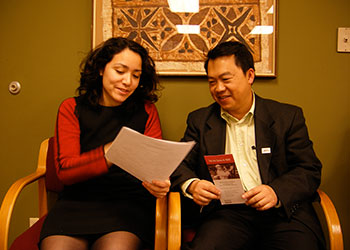News > Immigration In Minnesota
Immigrants Building Worthington

Posted on Mar 09 2020
Walk down Tenth Street in Worthington, the southwest Minnesota town’s main street, and you see business after thriving business: restaurants, cleaners, a bank, a repair shop, a Mexican grocery on one block, an Asian grocery on another. In many other small towns, one vacant storefront sits next to another all through their depressed business districts. Not here: Worthington’s downtown looks busy and healthy.
The town’s population growth, boosted by waves of immigrant arrivals over the past 30 years, maintains this healthy business district. Worthington is a city of immigrants, with population growing from a low of 9,977 in 1990 to more than 13,000 today. The small city’s population is about 41 percent Hispanic or Latino, ten percent Asian, and 7 percent African or African American, according to U.S. census figures.
Mexican-American and Mexican workers were among the first to arrive, drawn by jobs at the Swift meatpacking plant. The plant, and Worthington, made national headlines in 2006, when Immigration and Customs Enforcement (ICE) raided six Swift plants and arrested about 1,300 immigrant workers in the largest immigration raids the country had seen. Devastated by the arrests of 200 friends, family, and neighbors, the community rallied to care for children left without parents and to help families who lost loved ones.
In 2007, Swift sold the meatpacking plant to JBS, which still operates the plant and JBS, still employs hundreds of immigrant workers. They include not only the Mexican and Mexican-American workers who were the first arrivals in Worthington, but also many immigrants from Guatemala, as well as Hondurans, Salvadorans, and a few Nicaraguans. Many of the Mexican and Central American immigrants and their children find a church home at St. Mary’s Catholic Church, where a few hundred attend a Saturday evening Spanish Mass and more than a thousand may pack the Sunday morning Spanish Mass.
Worthington’s Ethiopian community has grown large enough to begin building Tsadkane Mariam Ethiopian Orthodox Church. Other substantial immigrant groups include Karen and Karenni refugees from Burma/Myanmar and Hmong immigrants who came to the United States after the 1970s U.S. war in Southeast Asia.
While some long-time residents resent that change, many others welcome Worthington’s newer residents. Worthington Mayor Michael Kuhle says that immigration’s benefits to Worthington “far, far outweigh any perceived disadvantages.” In an October 2, 2019 Counterpoint article published in the Star Tribune, Mayor Kuhle writes:
“Immigration has helped to provide badly needed employees for these businesses and the surrounding area. The farming community has benefited from the availability of immigrant workers. Without immigrants moving to Worthington, we would likely be a community in decline.”
Population declines in rural areas of the United States have left many small towns struggling to survive. Worthington is an example of the counter-trend: small towns that are seeing a rebound because of immigration. According to the Center for American Progress, more than a million immigrants have moved to rural counties since 1990, and “between 2000 and 2005, more than 200 nonmetropolitan counties would have lost overall population if new Hispanic residents had not moved to or started families in those counties.”
Immigrants provide a younger workforce and a high degree of entrepreneurship, both of which foster economic growth. Immigrant medical professionals provide desperately needed health care in areas where doctors are scarce. Immigrant children boost enrollment, keeping schools open.
Immigrants come to rural Minnesota for jobs, but also for reasons that will sound familiar to many long-time rural residents, as reported in a Federal Gazette article:
“Abebe Abetew, a native of Ethiopia who lived in Washington, D.C., before moving to Worthington to work at JBS, pointed to the low crime rate and low cost of living as amenities, as well as a short commute time. ‘When I lived in D.C., I spent three hours a day getting to and from work. Now my commute is five minutes,’ he said.”
While most Minnesota immigrants still live in the metro area, Worthington offers a demonstration of rural immigration that works. That demonstration is repeated in rural communities across Minnesota. Immigrants keep Worthington and all of Minnesota growing!




